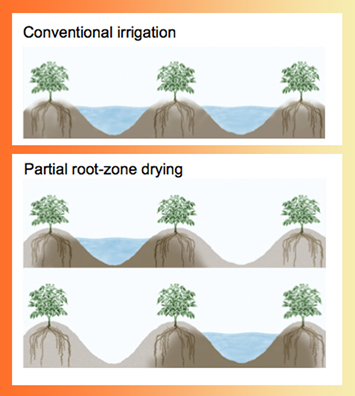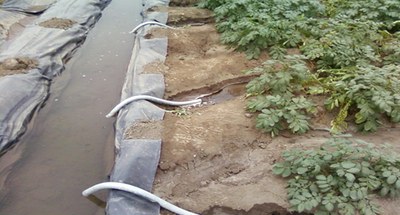Potato cultivation takes place all over the world, with production escalating particularly in areas across Asia and Africa over the past ten years. As the potato expands into new areas, the crop is able to alleviate hunger for millions of the world’s poor. However, this expansion can create stress on the environment and water supplies, particularly in drought prone areas where water is a scarcity. This is a problem that is further augmented by the projected challenges posed by climate change. In order to address this issue head-on, the International Potato Center (CIP) has been undertaking a series of studies analyzing and testing irrigation techniques in order to develop a system for producing sufficient potato crop yields in arid climates with poor water supplies.
The irrigation technique being tested by CIP is known as partial root-zone drying (PRD), which is an irrigation process shown to increase water use efficiency without significant yield reductions. The PRD technique basically consists of irrigating approximately half of the root system of a crop while the other half is left to dry. Following a certain period of time, the dry half of the root system is irrigated while the wet half is left to dry. The theory holds that during the early stages of water stress a hormone (Abscisic Acid-ABA) is synthesized in the drying roots of the crop. ABA is transported to the leaves where it reduces water loss by inducing stomatal closure and decreasing water loss through transpiration. Translated, what this means is that a plant’s root system is initially starved in order to train the plant to be more efficient with the water it is allotted, thus extending photosynthetic activity.
The PRD technique has been applied to a number of crops around the world with very positive results, but CIP was interested to see if the same technique could be successfully applied to the potato – and if so, what percentages and irrigation frequencies would be ideal in terms of significantly cutting water costs while still producing the same crop yields.
Over the past few years, CIP’s Production Systems and the Environment (PSE) Sub-Program, along with CIP’s Regional Office for East, Southeast Asia and the Pacific (ESEAP) has undertaken research focused on the effect of PRD irrigation on potato tuber yield and water use efficiency. The overall results of this research has demonstrated that a PRD with 50% of amount water of the control treatment (full irrigation) gives similar tuber yield quantity and a better tuber quality when compared to conventional irrigation with a concomitant water saving.
In a recently published work carried out by CIP’s PSE, titled, “The effect of partial root-zone drying irrigation timing on potato tuber yield and water use efficiency,” a PRD trial was tested with different initiation timing, duration and levels of water restriction under field conditions in an arid region. The aims of the study were to assess water use efficiency under contrasted PRD treatments with different water restrictions and irrigation timings, and to determine whether the PRD treatment induced water stress tolerance as indicated by osmotic adjustment and “stay green” effects.
This experiment was conducted on the CIP campus in Lima, which has arid conditions with no rain, and thus without a rainfall confounding effect. The experimental unit consisted of 4.5 m2 plots divided into six rows (0.9 m apart from each other) with five ridges. The ridges are of course necessary to ensure that only one half of the root system is irrigated, while the other half remains dry. The irrigation treatments included a full irrigation, which supplied 100% of the crop water demand, a deficit irrigation, which supplied 50% of the crop water demand, and two separate PRD treatments, which supplied 50% and 25% of the crop water demand respectively. In order to test the effect of different water restriction initiation timings, the irrigation treatments began at six and eight weeks after planting.
The results for the PRD were positive with the six-week water restriction timing with a PRD of 50% being the most effective. This PRD allowed for a 21% water saving and a water use efficiency increment of 19% with no reduction of tuber yield when it was compared with the control crop which received 100% of the crop water demand.
This study answers many questions relating to the most appropriate combination of the initiation timing, duration and intensity of water restriction during the PRD technique, and to understand the mechanisms that support water stress tolerance without yield tuber reduction. While further studies are necessary to test other traits that allow water stress tolerance without penalization in tuber yields, the CIP-led study produced a very successful result, and showed that an early PRD, initiated six weeks after planting, with a watering level equivalent to 50% of full irrigation, increased water use efficiency with no yield reduction relative to full irrigation. This essentially means that by introducing an innovative practice, farmers who live in semi-arid climates, may be able to effectively produce the same crop yields as potato farmers who have a surplus of water.



